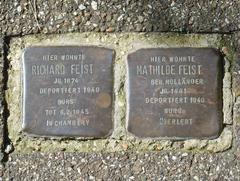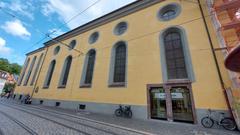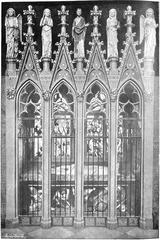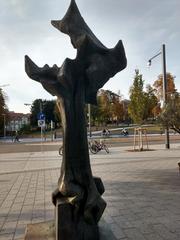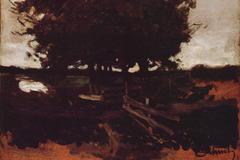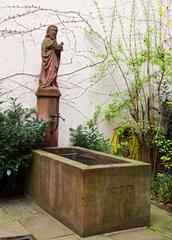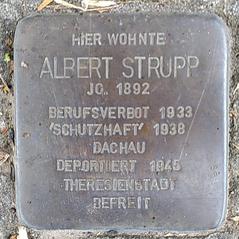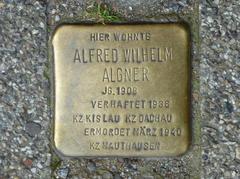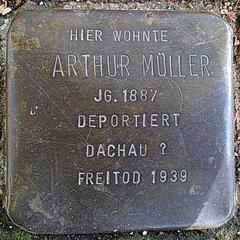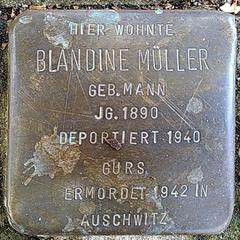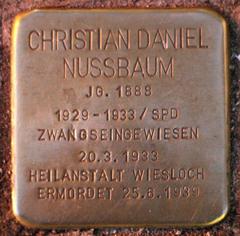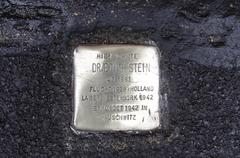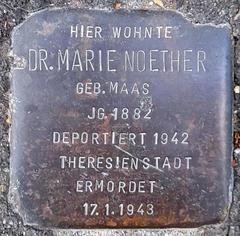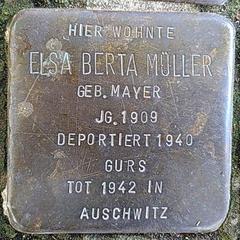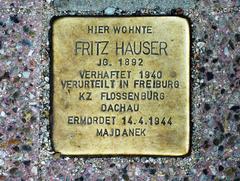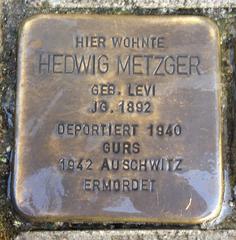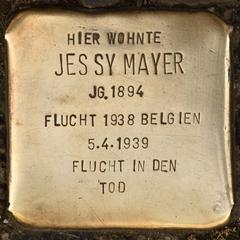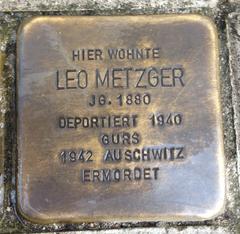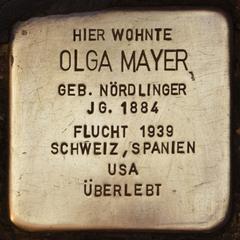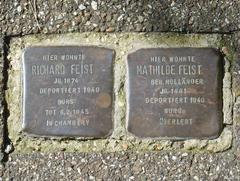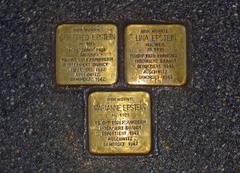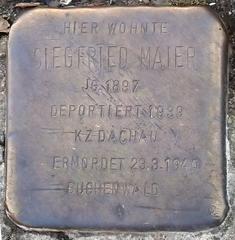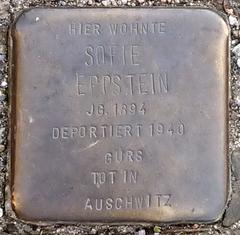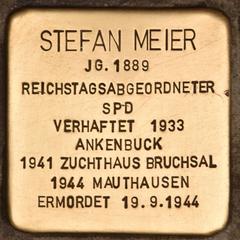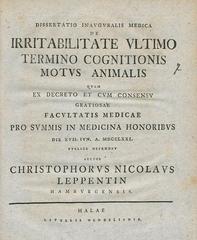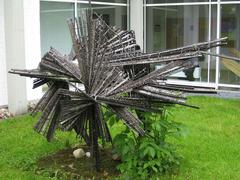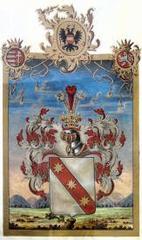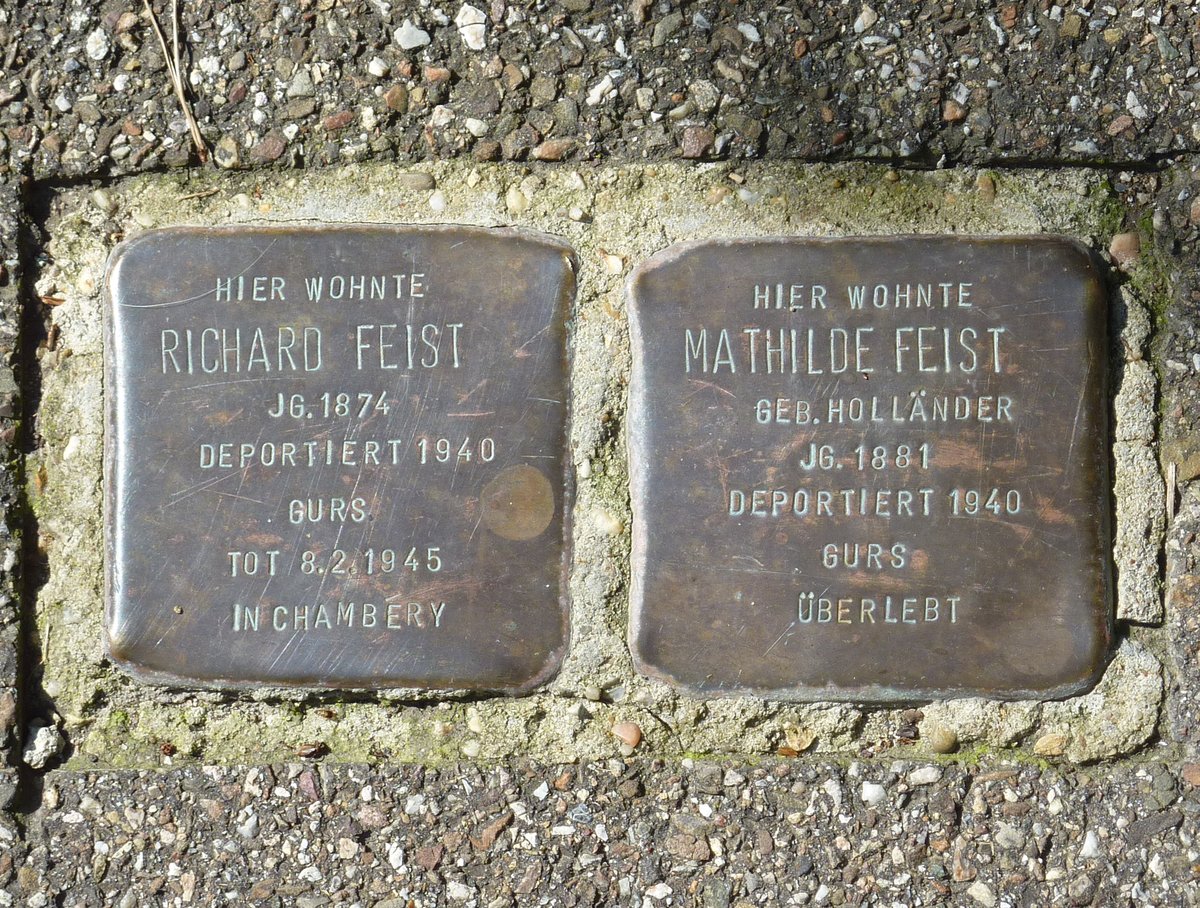
Stolperstein Mathilde Feist Freiburg: Visiting Hours, Tickets, and Guide
Date: 14/06/2025
Introduction
The Stolperstein dedicated to Mathilde Feist in Freiburg im Breisgau is a powerful memorial that invites both residents and visitors to confront the personal stories behind the Holocaust. Stolpersteine—small brass plaques embedded in sidewalks—commemorate those whose lives were destroyed by National Socialism, restoring a name and a story to each victim. This guide provides historical context, practical information for visiting, and insights into the cultural and educational significance of the Mathilde Feist Stolperstein, helping you engage with this unique site of remembrance.
Table of Contents
- Introduction: Meaning and Purpose of Visiting the Stolperstein for Mathilde Feist
- Historical Background: The Stolpersteine Project
- Mathilde Feist: Life and Persecution
- Visiting the Mathilde Feist Stolperstein
- The Significance of Decentralized Memorials
- Educational and Reflective Dimensions
- Nearby Attractions and Further Exploration
- Frequently Asked Questions (FAQ)
- Summary and Visitor Recommendations
- Sources and Further Reading
Why Visit the Stolperstein for Mathilde Feist?
Encountering the Stolperstein for Mathilde Feist in Freiburg is a deeply personal experience. Unlike centralized monuments, Stolpersteine bring history into the rhythm of everyday life, marking the very places where victims last lived freely. Mathilde Feist’s memorial transforms an ordinary sidewalk into a site of reflection, remembrance, and empathy. For those interested in history, Holocaust education, or meaningful travel, visiting this Stolperstein offers both insight and a tangible connection to the past (Stolpersteine.eu; Stolpersteine-in-freiburg.de).
Historical Background: The Stolpersteine Project
Origin and Philosophy
The Stolpersteine project was initiated in 1992 by German artist Gunter Demnig. The project’s goal is to commemorate individuals persecuted and murdered by the Nazi regime—Jews, Roma and Sinti, political dissidents, people with disabilities, LGBTQ+ individuals, Jehovah’s Witnesses, and others—by embedding small, engraved brass plaques in front of their last freely chosen residence or workplace. The guiding principle, drawn from the Talmud—“A person is only forgotten when their name is forgotten”—drives the project’s focus on restoring names to public memory (Stolpersteine.eu; pragueviews.com).
Artistic and Physical Characteristics
Each Stolperstein is a 10 x 10 cm concrete block topped with a hand-engraved brass plate. The inscription typically begins with “Hier wohnte” (“Here lived”), followed by the victim’s name, birthdate, deportation details, and fate. The brass is left unvarnished, requiring regular cleaning—a symbolic act of care and remembrance. The stones are placed flush with the pavement, so reading them requires visitors to pause and bow their heads, a gesture of respect (pragueviews.com).
Scale and Community Engagement
As of 2025, over 100,000 Stolpersteine have been installed in more than 30 European countries, making it the world’s largest decentralized memorial. The process of researching and sponsoring a Stolperstein often involves local communities, schools, and families, transforming installation into a participatory act of remembrance (Stolpersteine.eu; stolpersteine-in-freiburg.de).
Mathilde Feist: Life and Persecution
Mathilde Feist was a Jewish resident of Freiburg, born in 1875. Like many others, she became a victim of the Nazi regime’s escalating persecution. In 1940, during the Wagner-Bürckel Aktion, she was deported—alongside hundreds of other Jews from Baden and Saarland—to the Gurs internment camp in southern France. The conditions at Gurs were dire, marked by overcrowding and deprivation, and Mathilde Feist died there in 1940 (Gedenkbuch Baden-Württemberg).
Her Stolperstein not only marks her last freely chosen residence but also stands as a testament to the fate of Freiburg’s Jewish community under National Socialism (Wikipedia: Stolpersteine in Freiburg-Neuburg).
Visiting the Mathilde Feist Stolperstein
Location, Directions, and Accessibility
- Address: Basler Straße 38, 79100 Freiburg im Breisgau, Germany
- Public Transport: Take tram line 3 from Freiburg Hauptbahnhof (main station) toward Vauban, alighting at “Johanneskirche.” Basler Straße 38 is a short walk from the stop.
- On Foot: About a 15-minute walk south from the city center (Bertoldsbrunnen).
- Accessibility: The pavement is flat and suitable for wheelchairs and strollers. The stone is embedded directly in front of the building entrance (Google Maps).
Visiting Hours and Admission
- Open Access: The Stolperstein is in a public space and can be visited at any time, year-round.
- Admission: No ticket or entrance fee is required.
Guided Tours and Events
- Guided Tours: Local organizations such as the Initiative Stolpersteine für Freiburg offer walking tours that include the Mathilde Feist Stolperstein. These tours provide deeper historical context and are highly recommended for those seeking a comprehensive understanding (Stolpersteine-in-freiburg.de; visit.freiburg.de).
- Remembrance Events: Annual events are held on Holocaust Remembrance Day (January 27) and the anniversary of the Gurs deportations (October 22). Visitors are welcome to participate.
Visitor Etiquette and Practical Tips
- Respectful Behavior: Avoid standing directly on the stone; pause to read and reflect.
- Symbolic Acts: Placing small stones or flowers is encouraged as a sign of respect.
- Cleaning the Stone: Carry a soft cloth to gently polish the brass, a symbolic gesture of remembrance.
- Photography: Discreet, respectful photography is permitted.
The Significance of Decentralized Memorials
Stolpersteine transform the urban landscape into a living memorial. Their decentralized, ground-level placement brings remembrance into daily routines, subtly challenging indifference and making memory a shared civic responsibility. The act of “stumbling” upon a stone is both literal and metaphorical—interrupting daily life to honor lost neighbors and reflect on history’s relevance today (Stolpersteine.eu; Folklife Magazine).
The project’s collaborative model encourages community engagement, with research, sponsorship, and maintenance often undertaken by local residents, schools, and organizations.
Educational and Reflective Dimensions
Stolpersteine are widely used as educational tools. Schools and universities in Freiburg and throughout Europe incorporate them into curricula, prompting students to research the lives behind each stone. Guided tours, digital resources, and the Stolpersteine app deepen understanding and foster empathy. The stones’ presence in daily life prompts enduring questions about memory, justice, and the responsibilities of citizenship (Stolpersteine.eu).
Nearby Attractions and Further Exploration
- Other Stolpersteine: Freiburg has over 480 Stolpersteine. Consider visiting others nearby (e.g., Basler Straße 36 and 40) using maps from Stolpersteine-in-freiburg.de.
- Johanneskirche: A nearby neo-Gothic church.
- Augustiner Museum: Offers broader context on Freiburg’s history and Jewish community (Augustiner Museum).
- Interactive Resources: The Audiala app provides guided audio tours and interactive maps (Audiala app).
Frequently Asked Questions (FAQ)
What is a Stolperstein?
A small brass plaque embedded in the pavement to commemorate victims of Nazi persecution.
Where is the Mathilde Feist Stolperstein located?
Basler Straße 38, Freiburg im Breisgau.
Are there visiting hours or tickets?
No; the stone is accessible at any time and free to visit.
Are guided tours available?
Yes; local organizations offer informative walking tours.
Is the site wheelchair accessible?
Yes; the pavement is flat and accessible.
Can I participate in cleaning or commemorative events?
Yes; visitors are welcome to join community remembrance activities.
Summary and Visitor Recommendations
The Mathilde Feist Stolperstein offers a powerful, personal connection to the Holocaust and to Freiburg’s complex history. By visiting, you participate in a living act of remembrance, ensuring that the names and stories erased by National Socialism remain present in the city’s fabric. Access is free and open, with guided tours and digital tools available to enrich your experience. Whether you pause for a quiet moment or join a community event, your visit makes memory an active, ongoing process.
For a deeper exploration, use the Stolpersteine app, join a guided tour, and explore additional memorial sites throughout Freiburg.
Sources and Further Reading
- Stolpersteine Project Official Website
- Stolpersteine in Freiburg im Breisgau
- History of Mathilde Feist and Gurs Deportation, Gedenkbuch Baden-Württemberg
- Wikipedia: Stolpersteine in Freiburg-Neuburg
- Stumbling Stones – Memorials of the Holocaust, Prague Views
- Germany’s Stumbling Stones: A Unique Holocaust Memorial, Deutsche Welle
- Folklife Magazine: Stumbling Stones Holocaust Memorials, Smithsonian Institution
- Freiburg Tourism Information
- Augustiner Museum
- Audiala app
